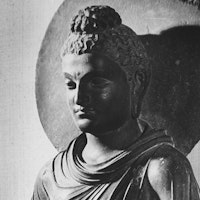All that we are is the result of what we have thought. It is founded on our thoughts. It is made up of our thoughts.
Gautama Buddha

All That We Are
Topic: Wisdom & Understanding
All that we are is the result of what we have thought. It is founded on our thoughts. It is made up of our thoughts. If one speaks or acts with a pure thought, happiness follows one, like a shadow that never leaves.
Gautama Buddha, also known as Siddhartha Gautama, was a spiritual teacher and the founder of Buddhism. Born in the 6th century BCE in Lumbini, now modern-day Nepal, he was destined for greatness. At the age of 29, he renounced his luxurious life as a prince and embarked on a spiritual quest to find the ultimate truth about human suffering and the nature of existence.
After years of intense meditation and self-discipline, Gautama attained enlightenment under a Bodhi tree in Bodh Gaya, India, at the age of 35. He became the Buddha, which means "the awakened one" or "the enlightened one." Gautama Buddha spent the rest of his life teaching the Four Noble Truths and the Eightfold Path, which formed the core principles of Buddhism. His teachings emphasized the importance of overcoming desire and attachment to achieve liberation from suffering. Known for his compassion and wisdom, Gautama Buddha's teachings have had a profound impact on millions of people worldwide, inspiring them to seek inner peace and spiritual enlightenment. His legacy as a spiritual leader and philosopher continues to resonate and guide individuals on their spiritual journeys to this day.
Dhammapada
Müller F. Max, and Jack Maguire. Dhammapada: Annotated & Explained Translation by Max Muller ; Annotation by Jack Maguire. SkyLight Paths Pub., 2002, [Dhammapada 2]

Gautama Buddha
Theme: Wisdom

About the Buddha’s Teachings from Dhammapada 2 [Commentary]
The essence of Buddha’s quote speaks directly to the profound impact of our thoughts on our reality, articulating a fundamental truth in a straightforward manner: our lived experiences are largely shaped by our mental constructs. It signifies a clear relationship between pure thoughts and the ensuing happiness that trails one’s actions when grounded in such thoughts. The purity of thought, denoting alignment with virtues such as compassion and understanding, leads to a state of happiness that is as constant and unyielding as one’s shadow.
Delving into the Dhammapada, one finds a reservoir of wisdom on the importance of mindfulness and right thinking. This revered text, through the ages, conveys Buddha’s enduring insight on the potency of the mind in influencing life’s trajectory. As Huston Smith pointed out, the Dhammapada begins with an acknowledgement of the mind’s capacity to shape reality, suggesting a path of mastery through mindfulness. It underscores the attainability of a state of happiness and joy through vigilant management of one’s thoughts.
Buddha’s quote, alongside the commentary, underscores the indissoluble link between our thoughts and our experience of happiness. It serves as a reminder of the inherent responsibility each individual holds in nurturing a mental environment conducive to happiness and joy. The clarity in this teaching offers a guide for individuals to engage thoughtfully with their inner world, fostering a landscape of wholesome thoughts. Through such engagement, the pursuit of happiness transitions from a transient aim to a tangible, lived reality, gently escorted by the consistency of pure thoughts.
Dhammapada 1-2
Huston Smith [excerpt from The World’s Religions, Buddhism, the Eightfold Path]
“The West has found the last two steps in the Eightfold Path [Right Mindfulness and Right Concentration] of special importance for the understanding of the human mind and its workings… No teacher has credited the mind with more influence over life than did the Buddha. The best-loved of all Buddhist texts, the Dhammapada, opens with the words, “All we are is the result of what we have thought.” And, respecting the future, it assures us that “all things can be mastered by mindfulness.”
Carl Rogers [Humanistic Psychology] writes, “human behavior is to be trusted, for in these moments the human organism becomes aware of its delicacy and tenderness towards others.” The Buddha saw ignorance, not sin, as the offender. More precisely, insofar as sin is our fault, it is prompted by a more fundamental ignorance — most specifically, the ignorance of our true nature.”
—Huston Smith [excerpt from The World’s Religions, Buddhism, the Eightfold Path, 7. Right Mindfulness and 8. Right Concentration] pp. 109-110.
Buddhism & Happiness
The first and second verses (above) of the Dhammapada, the earliest known collection of Buddha’s sayings, talk about suffering and happiness. So it’s not surprising to discover that Buddhism has a lot to offer on the topic of happiness. Buddha’s contemporaries described him as “ever-smiling” and portrayals of Buddha almost always depict him with a smile on his face. But rather than the smile of a self-satisfied, materially-rich or celebrated man, Buddha’s smile comes from a deep equanimity from within.
—Mark K. Setton [“Buddha.” Pursuit of Happiness, www.pursuit-of-happiness.org/history-of-happiness/buddha/] p. 1.
Equanimity: Peace of Mind & Happiness
Buddhism pursues happiness by using knowledge and practice to achieve mental equanimity. In Buddhism, equanimity, or peace of mind, is achieved by detaching oneself from the cycle of craving that produces dukkha. So by achieving a mental state where you can detach from all the passions, needs and wants of life, you free yourself and achieve a state of transcendent bliss and well-being.
As described in the first verse of the Dhammapada, for Buddha, mental dysfunction begins in the mind. The Buddha encouraged his followers to pursue “tranquility” and “insight” as the mental qualities that would lead to Nirvana, the Ultimate Reality. As mentioned earlier, the Eightfold Path as a whole is said to help one achieve these qualities. In particular, the areas of mental cultivation, which include right effort, right mindfulness, and right concentration, are the mental skills and tools used for achieving happiness.
—Mark K. Setton [Buddha, Pursuit of Happiness, www.pursuit-of-happiness.org/history-of-happiness/buddha/] pp. 3-4.
Equanimity is a very deep matter in Buddhism. It is one of the Seven Factors Of Awakening, and one of the hallmark characteristics of the jhānas (states of concentration). Notice, for example, the difference between calm and equanimity. Calm is when you don’t have reactions. You’re chilled out. But with equanimity, you’re not reacting to your reactions; they stay in the mudroom. It’s as if the reactions are surrounded with a lot of spaciousness. You prefer the pleasant to continue and the unpleasant to end—that’s OK. But you don’t even react to not getting that preference. You just surround it with space, and that’s where freedom is. I think that’s how people like the Dalai Lama can be sorrowful about what’s happening in Tibet, and yet simultaneously have enormous equanimity around it.
Calm is based on conditions, and thus not that reliable. But equanimity is based on insight, wisdom, and is thus much more dependable. For example, disenchantment is a key factor of equanimity. We start to realize, “Won’t get fooled again.” Ice cream tastes like ice cream, orgasms are orgasms, being angry is being angry. Winning an argument, being right and showing them the error of their ways is just that. After a while you go, “so what?” Wisdom allows you to let go of the lesser pleasure, chasing the pleasant or resisting the unpleasant, for the greater pleasure of equanimity.”
—Rick Hanson, Ph.D. [Mind Changing Brain Changing Mind].
Resources
Related Quotes
Copyright © 2017 – 2024 LuminaryQuotes.com About Us